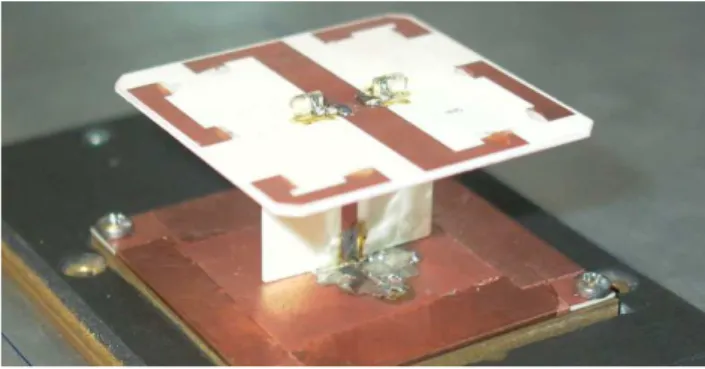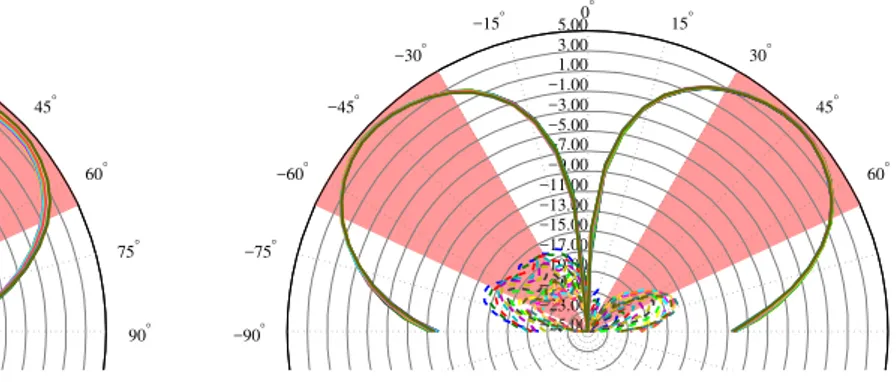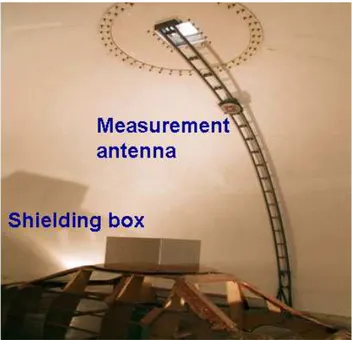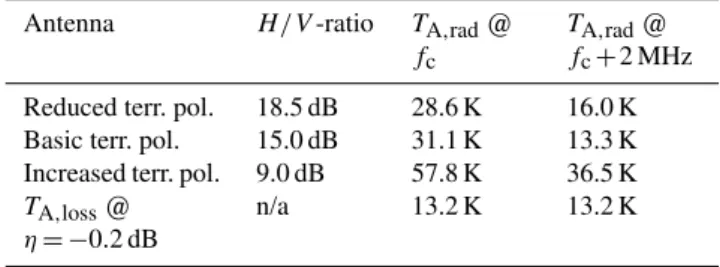G. Saala, D. M ¨uller, J. Hopf, and S. Lindenmeier
Institut f¨ur Hoch- und H¨ochstfrequenztechnik, Universit¨at der Bundeswehr M¨unchen, Werner-Heisenberg-Weg 39, 85577 Neubiberg, Germany
Abstract. The link margin for satellite communication ser-vices targeting mobile users is tight. This leads to reception problems in areas with strong fading scenarios like urban ar-eas or forested arar-eas with dense foliage. In order to avoid loss of service in urban areas with week coverage by satellite signals, terrestrial repeaters are used. Therefore in the design of antennas for mobile reception of satellite services, an op-timized characteristics for the satellite constellation, as well as an adequate coverage of the terrestrial repeaters has to be accounted for. In this paper an antenna with optimum shaped pattern for the satellite mode and adjustable gain for vertical polarization is investigated. Beside constraints regarding the radiation pattern, measurements concerning the dependence of the antenna on noise temperature and therefore the behav-ior in real noisy environments are carried out. A comparison with a conventional antenna shows the high performance of the new antenna in combination with a very low volume re-quirement.
1 Introduction
Services in satellite communications are not only set up for stationary receiver stations any more. During the last decade more and more services are targeting also mobile users not only for telephony but also for broadcasting radio and data services. Satellite systems such as Satellite Digital Audio Radio Services (SDARS) in the USA and Worldspace in Africa, Europe and parts of Asia, are already in operation. Aspects of the coverage of Europe by Worldspace are exam-ined in Sallam et al. (2008).
For each service a different constellation of satellites might be reasonable, depending on area of coverage, data
Correspondence to:G. Saala (gerd.saala@unibw.de)
Fig. 1. Sketch of the geostationary satellite constellation for 2-D-approximation of the elevation angle above the horizon, the satellite is seen under from an earth station.
rates and available transmission power of the satellite. For a wide area of coverage the geostationary orbit (GEO) is cho-sen for several systems, like Worldspace and XM-SDARS, whereas other systems operate in high earth orbits (HEO), such as Sirius-SDARS which is described in Briskman and Prevaux (2004) using several satellites to realize the continu-ous coverage of the service. An overview of several satellite services is given in Lida et al. (2003).
For a coverage of the USA and Europe the minimum lat-itude is approximately Latmin≈26◦N for the southern point
of Texas. The maximum latitude for the north of Denmark is approximately Latmax≈57◦N. From Fig. 1, with an easy
two dimensional approximation it can be seen, that geosta-tionary satellites in these areas of Europe and the USA are seen in an elevation angle from 25◦to 60◦(Morgan and
Fig. 2. Complete antenna structure with vertical feed section real-ized as double sided parallel strip line.
applications. Hence, the radiation pattern should be omni-directional over the azimuth. A further constraint arises from the sufficient coverage of areas with strong fading scenar-ios or weak signals like urban areas. In those areas the cov-erage is supported by additional terrestrial repeaters which transmit in vertical polarization. In this paper, an antenna with an adjustable power ratio between vertical and horizon-tal polarization is investigated. Considering the vertical po-larization with respect to the performance of the reception of satellite signals, also the noise behavior of the antenna with better terrestrial reception is analyzed. Finally field tests are presented which compare the performance in signal to noise ratio (SNR) of the new antenna type with a commercially available antenna with respect to different receiving environ-ments.
2 Antenna structure
The principle of a new antenna structure has been presented in Saala et al. (2009). It consists of an electrically large loop structure over a ground plane. This loop structure is seg-mented in order to achieve a homogeneous current distribu-tion over the complete circumference of the horizontal part of the antenna. With that homogeneous current over the ground plane the main beam is directed to an elevation angle of ap-proximately θ≈45◦
and a null at the zenith and horizon. In the following several variants of this antenna, shown in Fig. 2, are investigated with respect to the adjustment of the vertical polarized part of the radiation pattern. The antennas are designed for a center frequency offc=1.486 GHz.
2.1 Basic operation mode
The basic antenna consists of the horizontal loop structure which is fed by horizontal double sided parallel strip line connected to a vertically oriented feed section, e.g. coaxial line. By proper design an additional matching network can be avoided at the base point of the coaxial line. The verti-cal part can also be realized by a double sided parallel strip
5.00 3.00 1.00 −1.00 −3.00 −5.00 −7.00 −9.00 −11.00 −13.00 −15.00 −17.00 −19.00 −21.00 −23.00 −25.00
90° 75° 60° 45° 30° 15° 0° −15° −30°
−45°
−60°
−75°
−90°
Fig. 3.Basic antenna setup with coaxial feed. 16 elevation cuts for vertical (−−) and horizontal (—) polarization in azimuthal steps of
1ϕ=11.25◦.
5.00 3.00 1.00 −1.00 −3.00 −5.00 −7.00 −9.00 −11.00 −13.00 −15.00 −17.00 −19.00 −21.00 −23.00 −25.00
90° 75° 60° 45° 30° 15° 0° −15° −30°
−45°
−60°
−75°
−90°
Fig. 4. Basic antenna setup with coaxial feed. 16 elevation cuts for right (—) and left (−−) hand circular polarization in azimuthal steps of1ϕ=11.25◦.
line for easier production. In Figs. 3 and 4 the radiation pat-terns are depicted for linear and circular polarizations, re-spectively. The horizontal polarization is perfectly rotational symmetric over the azimuth. The vertical polarization is more than 15 dB lower than the horizontal polarization. The circular polarizations are also equally balanced with a little asymmetry over the azimuth, which is due to the asymmetry of the vertical polarization caused e.g. by effects of the an-tenna chassis. With this anan-tenna a simultaneous reception of data streams transmitted in right and left hand polarization is possible without necessity of a switch, which might inter-rupt the data stream when switching from one polarization towards the other one.
2.2 Stronger terrestrial mode
Fig. 5. Simulation: Different values of capacitance introduced at the feed point of the antenna. Vertical (−−) and horizontal (—) polarized radiation pattern, the curves are average values over the azimuth.
0.00 −2.00 −4.00 −6.00 −8.00 −10.00 −12.00 −14.00 −16.00 −18.00 −20.00 −22.00 −24.00 −26.00 −28.00 −30.00
90° 75° 60° 45° 30° 15° 0° −15° −30°
−45°
−60°
−75°
−90°
C = 5 pF C = 3 pF C = 2.0 pF C = 0.75 pF
Fig. 6.Simulation: Different values of capacitance introduced at the feed point of the antenna. Right (—) and left (−−) hand circular polarized radiation pattern, the curves are average values over the azimuth.
point of the vertical feed section of the antenna. With this capacitor a common mode current is excited on the vertical section, which leads to a raised radiation in vertical polariza-tion.
Compared to the antenna operating in its basic mode with mainly horizontal polarized radiation, the introduction of a capacitor changes the input impedance of the antenna, which cannot easily be accounted for by change of the loop-structure or the feed line. Hence an additional matching net-work is required. The power ratio between the horizontal and vertical polarization is not influenced by this matching network, compared to the unmatched operation.
Figures 5 and 6 show simulation results of antennas with different values of capacitors introduced at the feed point of the antenna. In order to show the tendency of the power ra-tio independent of the matching, the graphs are normalized values of each antenna. For the linear polarizations a fine graduation over the capacitance is achieved. For very small capacitors the vertical polarization even exceeds the
hori-Fig. 7.Measurement: Vertical (−−) and horizontal (—) polarized radiation pattern for different capacitances at the feed point. Each curve is the average over four equally spaced elevation cuts with
1ϕ=45◦.
0.00 −2.00 −4.00 −6.00 −8.00 −10.00 −12.00 −14.00 −16.00 −18.00 −20.00 −22.00 −24.00 −26.00 −28.00 −30.00
90° 75° 60°
45° 30° 15° 0°
−15° −30°
−45°
−60°
−75°
−90°
C = ∞ C = C0 C = C0/2 C = 0 pF C = 0 pF + Stub
Fig. 8. Measurement: Right (—) and left (−−) hand circular po-larized radiation pattern for different capacitances at the feed point. Each curve is the average over four equally spaced elevation cuts with1ϕ=45◦.
zontal polarization. Because of the excitation of the common mode current at the base point of the antenna the phase for the received signals is not necessarily the same for vertical and horizontal polarization. This leads to an imbalance be-tween the circular polarizations (Fig. 6) which gets greater with rising vertical polarization. This imbalance can be used to account for an imbalance of the power distribution to the two circular polarizations on the satellite.
For the measurements, shown in Figs. 7 and 8, the capac-itors at the base point of the antenna and the matching net-work have been introduced on the rear side of the ground plane. The plots for the linear polarizations in Fig. 7 show the precisely adjustable power ratioH /V between the hori-zontal and vertical polarization starting from the basic mode operation for the short with Cfeed= ∞ and ending with a
large reactance for the open circuit withCfeed=0 pF.
5.00 3.00 1.00 −1.00 −3.00 −5.00 −7.00 −9.00 −11.00 −13.00 −15.00 −17.00 −19.00 −21.00 −23.00 −25.00 90° 75° 60° 45° 30° 15° 0° −15° −30° −45° −60° −75° −90°
Fig. 9. Capacitor at the base of the vertical feed structure. 16 el-evation cuts for vertical (−−) and horizontal (—) polarization in azimuthal steps of1ϕ=11.25◦.
5.00 3.00 1.00 −1.00 −3.00 −5.00 −7.00 −9.00 −11.00 −13.00 −15.00 −17.00 −19.00 −21.00 −23.00 −25.00 90° 75° 60° 45° 30° 15° 0° −15° −30° −45° −60° −75° −90°
Fig. 10.Capacitor at the base of the vertical feed structure. 16 eleva-tion cuts for right (—) and left (−−) hand polarization in azimuthal steps of1ϕ=11.25◦.
The radiation pattern of one antenna sample with increased shape of vertical the polarization, matched to 50is shown in Fig. 9 for the linear polarization with a power ratio of H /V ≈9 dB. The radiation pattern of the circular polariza-tions in Fig. 10 show an imbalance of up to 2 dB.
2.3 Suppression of the terrestrial mode
The increased gain in vertical polarization, described in Sect. 2.2, is due to a common mode current excited at the base of the vertical feed section. A small fraction of a com-mon mode current is also excited using a coaxial line or par-allel strip line, respectively for this feed section. For an addi-tional discrimination of the parasitic vertical polarized radia-tion a balanced unbalanced transiradia-tion could be introduced at the feed point of the antenna. Another solution is achieved by introducing two capacitors at the top of the vertical feed sec-tion. Thereby a common mode current is excited also at the top section of the vertical feed, which interferes destructively with the parasitic common mode current excited at the base point of the antenna. The resulting radiation pattern for this
5.00 3.00 1.00 −1.00 −3.00 −5.00 −7.00 −9.00 −11.00 −13.00 −15.00 −17.00 −19.00 −21.00 −23.00 −25.00 90° 75° 60° 45° 30° 15° 0° −15° −30° −45° −60° −75° −90°
Fig. 11. Capacitors at the top of the vertical feed section. 16 el-evation cuts for vertical (−−) and horizontal (—) polarization in azimuthal steps of1ϕ=11.25◦.
5.00 3.00 1.00 −1.00 −3.00 −5.00 −7.00 −9.00 −11.00 −13.00 −15.00 −17.00 −19.00 −21.00 −23.00 −25.00 90° 75° 60° 45° 30° 15° 0° −15° −30° −45° −60° −75° −90°
Fig. 12.Capacitors at the top of the vertical feed section. 16 eleva-tion cuts for right (—) and left (−−) hand polarization in azimuthal steps of1ϕ=11.25◦.
antenna is shown in Fig. 11 for the linear polarizations with a power ratio ofH /V≈18.5 dB. The left hand and right hand circular polarizations in Fig. 12 are almost balanced.
A comparison of the phases of the received signals of the antennas described in the last sections is shown in Fig. 13. Only for the basic mode the signals for vertical and horizon-tal polarization are in phase or anti-phase respectively, which is the reason for the very good balance between left and right hand circular polarizations in this case.
3 Noise measurements and antenna temperature
The system noise temperature TS at the antenna terminals
considering antenna losses, attenuation on the transmission line and noise of the amplifiers or receiver respectively, which is used to calculate the G/T of a satellite receiving antenna, is given by Kraus and Marhefka (2003) (Eq. 1).
TS=TA,rad+T0
1 ηA
−1
+T0
1 ηL
−1
+TR ηL
Fig. 13. Transmission phases for vertical (blue) and horizontal (green) polarizations; antenna in basic (—), stronger vertical (−−) and suppressed vertical polarization (···) mode.
Fig. 14.Measurement setup for determination of the antenna noise temperture.
In order to investigate the impact of the surrounding tem-perature on the noise characteristics of antennas with var-ied adjustment of the radiation pattern the three antennas de-scribed in Sects. 2.1, 2.2 and 2.3 are compared in noise mea-surements with respect to the radiation part of the antenna noise temperatureTA,rad.
Each of the three antennas are matched to the system impedance ofZS=50. In the noise measurement each
an-tenna is compared to the temperature of a reference resistor with a temperature ofTRef=T0=293 K, using the
measure-ment setup depicted in Fig. 14. The noise temperature of the low noise amplifier (LNA), the transmission line and the power amplifier are summarized in the receiver temperature TRat the input of the LNA. The Antenna TemperatureTA,rad
has to be determined. With the reference resistor switched to the low noise amplifier (LNA) the system noise temperature at the input of the receiver is given from Eq. (2). Equation (3) determines the measured noise temperature with the antenna under test switched to the receiver.
TS,Ref=T0+TR (2)
TS,A=TA,rad·ηA+TA,Loss+TR, (3)
whereTA,Loss=T0·(1−ηA)is the noise temperature
con-tributed by the losses in the antenna. The efficiency of the antenna is determined by calculations from gain measure-ments of the radiation pattern. Therefore the measured di-rectional characteristic of the antenna is compared with an
Fig. 15.Facility for antenna noise temperatureTAmeasurements.
ideal isotropic radiator at the same sampling points as in the measurement. With the power ratio
1PS=
PS,A
PS,Ref
= TS,A TS,Ref
(4) the radiation part of the antenna temperature TA,radcan be
determined to TA,rad=
1 ηA
·1PS·(T0+TR)−TR−TA,loss (5)
In the presented measurements the radiation part of the an-tenna temperature is investigated in dependence of the radi-ation characteristics, especially the power ratio between hor-izontal and vertical polarization. The measurements have been performed in a TA measurement facility shown in
Table 1. Results of noise measurements of three antennas with different power ratio (H /V) of vertical and horizontal polarization with center frequencyfc.
Antenna H /V-ratio TA,rad@
fc
TA,rad@
fc+2 MHz Reduced terr. pol. 18.5 dB 28.6 K 16.0 K Basic terr. pol. 15.0 dB 31.1 K 13.3 K Increased terr. pol. 9.0 dB 57.8 K 36.5 K
TA,loss@
η= −0.2 dB
n/a 13.2 K 13.2 K
4 Results of field-tests
For performance tests in real receiving scenarios the new tenna has been tested in comparison with a conventional an-tenna which can be switched between left and right hand cir-cular polarization. The optimum polarization matching due to switching is achieved by a seriously higher effort in the amplifier network. Both antennas have been placed in simi-lar positions on a car in three different scenarios. Hardware effort and volume requirement of the new antenna are less than half the one of the reference antenna. At the open range no surrounding objects have been present. In the second scenario the car has been positioned at the edge of a forest with moderate shading of the satellite signals by the trees. In the third case the test position has been inside a forest with shading by high trees. The signals for the circular polariza-tions have been imbalanced at the satellite with lower power for LHCP. The results in Table 2 show a comparable per-formance for the new antenna. With only half the hardware effort and volume requirement, in noisy environments like the forest it even outperforms the reference antenna.
5 Conclusions
A new antenna for mobile reception of signals transmitted via geostationary satellites is presented. With an optimum shap-ing of the radiation pattern it is possible to receive signals of left and right hand polarization simultaneously. There-fore disruption of the signal due to switching is avoided. For the coverage of terrestrial repeaters in urban areas, a method for an adjustable power ratio between vertical and horizon-tal polarization is presented. Noise measurements show how important a precisely adjustable vertical polarization is for satellite applications. Finally tests in real receiving scenar-ios have shown a very good performance of the new antenna comparable to a high end switchable reference antenna which needs seriously higher mounting volume and effort in fabri-cation.
Table 2. Results of field tests; comparison of the signal to noise ratio between commercially available antenna with the new loop type antenna.
SNR of Open
Range
Edge of Forest
Inside Forest
Ref. Antenna RHCP
9.74 dB 5.77 dB 2.60 dB
New Loop Antenna RHCP
9.68 dB 4.60 dB 4.40 dB
Ref. Antenna LHCP
6.90 dB 1.97 dB 1.00 dB
New Loop Antenna LHCP
4.43 dB 1.60 dB 2.30 dB
References
Briskman, R. D. and Prevaux, R. J.: S-DARS broadcast from in-clined, elliptical orbits, Acta Astronaut., 54, 503–518, 2004. Kraus, J. D. and Marhefka, R. J.: Antennas: for all applications,
vol. 3, McGraw-Hill, New York, 2003.
Lida, T., Pelton, J., and Ashford, E.: Satellite Communications in the 21st Century: Trends and Technologies, vol. 202, Prog. As-tronaut. Aero., 2003.
Morgan, W. L. and Gordon, G. D.: Communications Satellite Hand-book, vol. 1, John Wiley, New York, 1989.
Saala, G., Hopf, J., and Lindenmeier, S.: Small satellite car an-tenna for simultaneous reception of LHCP and RHCP signals, in: 3rd European Conference on Antennas and Propagation (Eu-CAP) 2009, vol. 3, 2698–2700, 2009.





